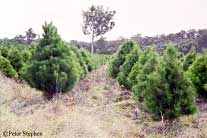|
|
|
Christmas trees

Until recently, most of the Christmas trees
bought by Australian families came from the early thinnings
of conventional pine plantations. However, specialised Christmas
tree production, including potted and cut trees, has expanded
enormously and now many Australians will only buy Christmas
trees that have been carefully nurtured into a dense, conical
shape.
Most Christmas trees come from repeatedly shearing selected,
densely branched varieties of Pinus radiata. But, despite
their slower growth rates, other species, including Douglas
fir (Pseudotsuga menziesii
or P. glauca), Norway spruce (Picea
abies) and native pine can attract a premium price.
The potential market for Christmas trees ranges from roadside
invitations "to cut your own" to supplying trees
to wholesale fresh produce markets. Although small trees are
the most common, some growers have received high prices for
large trees suitable for shopping centres or open-air displays.
Most of the information on growing and shearing Christmas
trees comes from the United States where Christmas falls in
winter. As different weather conditions can have a major effect
on species suitability, the appearance of foliage and fruit,
and shelf life, Australian farmers need to be cautious about
using American information as a guide to growing Christmas
trees in Australia.
Back to top
 |
|
|
|
